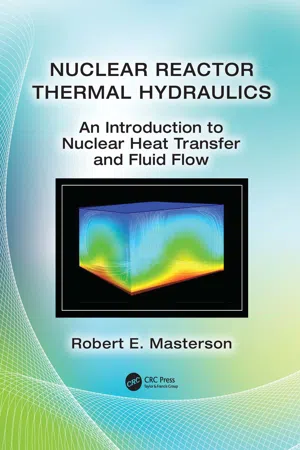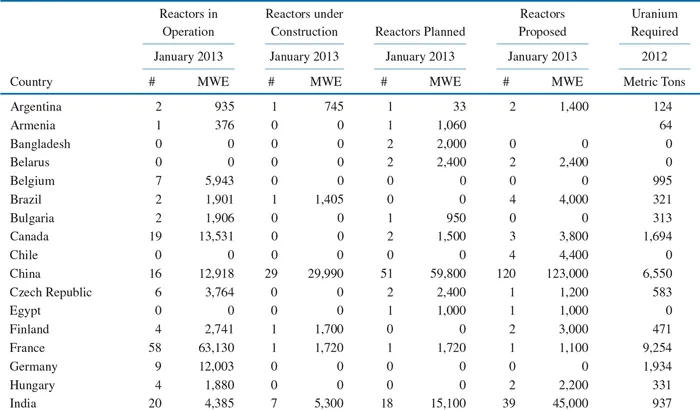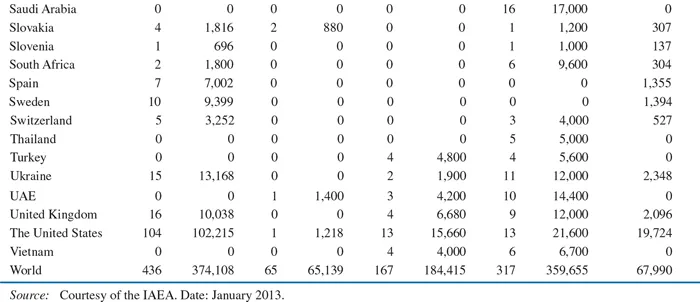
eBook - ePub
Nuclear Reactor Thermal Hydraulics
An Introduction to Nuclear Heat Transfer and Fluid Flow
Robert E. Masterson
This is a test
Partager le livre
- 1,354 pages
- English
- ePUB (adapté aux mobiles)
- Disponible sur iOS et Android
eBook - ePub
Nuclear Reactor Thermal Hydraulics
An Introduction to Nuclear Heat Transfer and Fluid Flow
Robert E. Masterson
Détails du livre
Aperçu du livre
Table des matières
Citations
À propos de ce livre
Nuclear Thermal-Hydraulic Systems provides a comprehensive approach to nuclear reactor thermal-hydraulics, reflecting the latest technologies, reactor designs, and safety considerations. The text makes extensive use of color images, internet links, computer graphics, and other innovative techniques to explore nuclear power plant design and operation. Key fluid mechanics, heat transfer, and nuclear engineering concepts are carefully explained, and supported with worked examples, tables, and graphics. Intended for use in one or two semester courses, the text is suitable for both undergraduate and graduate students. A complete Solutions Manual is available for professors adopting the text.
Foire aux questions
Comment puis-je résilier mon abonnement ?
Il vous suffit de vous rendre dans la section compte dans paramètres et de cliquer sur « Résilier l’abonnement ». C’est aussi simple que cela ! Une fois que vous aurez résilié votre abonnement, il restera actif pour le reste de la période pour laquelle vous avez payé. Découvrez-en plus ici.
Puis-je / comment puis-je télécharger des livres ?
Pour le moment, tous nos livres en format ePub adaptés aux mobiles peuvent être téléchargés via l’application. La plupart de nos PDF sont également disponibles en téléchargement et les autres seront téléchargeables très prochainement. Découvrez-en plus ici.
Quelle est la différence entre les formules tarifaires ?
Les deux abonnements vous donnent un accès complet à la bibliothèque et à toutes les fonctionnalités de Perlego. Les seules différences sont les tarifs ainsi que la période d’abonnement : avec l’abonnement annuel, vous économiserez environ 30 % par rapport à 12 mois d’abonnement mensuel.
Qu’est-ce que Perlego ?
Nous sommes un service d’abonnement à des ouvrages universitaires en ligne, où vous pouvez accéder à toute une bibliothèque pour un prix inférieur à celui d’un seul livre par mois. Avec plus d’un million de livres sur plus de 1 000 sujets, nous avons ce qu’il vous faut ! Découvrez-en plus ici.
Prenez-vous en charge la synthèse vocale ?
Recherchez le symbole Écouter sur votre prochain livre pour voir si vous pouvez l’écouter. L’outil Écouter lit le texte à haute voix pour vous, en surlignant le passage qui est en cours de lecture. Vous pouvez le mettre sur pause, l’accélérer ou le ralentir. Découvrez-en plus ici.
Est-ce que Nuclear Reactor Thermal Hydraulics est un PDF/ePUB en ligne ?
Oui, vous pouvez accéder à Nuclear Reactor Thermal Hydraulics par Robert E. Masterson en format PDF et/ou ePUB ainsi qu’à d’autres livres populaires dans Scienze fisiche et Energia. Nous disposons de plus d’un million d’ouvrages à découvrir dans notre catalogue.
Informations
1
Nuclear Power in the World Today
1.1 Types of Reactors and Their Characteristics
There are five basic types of reactors in relatively widespread use in the world today. These reactors use different combinations of coolants and different combinations of uranium and plutonium to generate the electrical power the world needs. The ability of a reactor to sustain a nuclear chain reaction over a long period of time is dependent upon the type of coolant, the composition of the core, and the enrichment of the fuel that is used. All reactors must be able to produce more neutrons than they consume for the fission chain reaction to continue over time. Control rods are then used to absorb the excess neutrons and keep the chain reaction under control. Conceptually, it is possible to subdivide the commercial nuclear power reactors in the world today into five broad categories:
- Pressurized water reactors (PWRs)
- Boiling water reactors (BWRs)
- Heavy water reactors (HWRs)
- Gas-cooled reactors (GCRs)
- Liquid metal fast breeder reactors (LMFBRs)
PWRs and BWRs use light water (i.e., ordinary water) to cool their cores, whereas HWRs, like the CANada Deuterium Uranium (CANDU) reactor, use heavy water in which the hydrogen atoms that are bound to the oxygen atom have an extra neutron in their nucleus. Heavy water absorbs fewer neutrons than light water does, and because of this, reactors that are cooled with heavy water do not need enriched uranium to be able to operate successfully. However, they can also use enriched uranium if the need arises. All commercial power reactors have a certain number of design features in common, including the need for fuel rods, control rods, and some type of liquid or gaseous coolant to cool the core. With the exception of GCRs (such as the advanced gas reactor [AGR] and the high-temperature, gas-cooled reactor [HTGR]), which can sometimes use the Brayton cycle in their primary loop, all other reactors use the Rankine thermal cycle to generate steam that is sent to the power turbines. PWRs, HWRs, and LMFBRs have two coolant loops (a primary loop and a secondary loop), whereas BWRs and GCRs have only one coolant loop. As we will mention in Chapter 4, some LMFBRs also have a third coolant loop (called an intermediate loop) to isolate the core from the steam generators (SGs). This prevents the liquid metal from interacting with the water and introducing radioactivity into the steam that drives the power turbines in the event of a pipe rupture.
1.2 Number of Power Reactors around the World
The number of power reactors in the world today has increased steadily since nuclear power was first introduced in the 1950s. Figure 1.1 shows how the number of power reactors has changed between the time that they were first introduced and the present day. Today, there are approximately 436 nuclear power plants in operation in 31 countries. As we mentioned previously, these nuclear power plants are usually implemented using a base-loading model, since the fuel is a very small part of the total cost of producing electric power from these plants. These 436 nuclear power plants have an average output of about 374 GW, and there are an additional 65 nuclear power plants under construction with a projected capacity of about 65 GW. The majority of these new plants are being built in China, India, and Russia (see Figure 1.2; Table 1.1).

FIGURE 1.1 The number of nuclear power plants operating in the world as a function of time. (Data supplied by the World Nuclear Association—see http://www.world-nuclear.org/.)

FIGURE 1.2 The number of nuclear reactors under construction, worldwide, by country. (Courtesy of the IAEA. Date: January 2013.)
By far the most common type of commercial power reactor in use in the world today is the PWR, which is manufactured and designed by Westinghouse, AREVA, and a number of other reactor vendors. Table 1.2 shows the breakdown of the current installed base of commercial power plants by reactor type. Notice that PWRs represent about two-thirds of the world’s total installed base of nuclear generating capacity at this time. BWRs, which are manufactured and designed by the General Electric Company (GE), are the next most common type of reactor in the world. The percentage of electrical power generated in each country by these power plants is also shown in Figure 1.3. Notice that nuclear power generates about 20% of the total electrical power output of the United States, whereas it generates almost 80% of the electrical power produced in France. Countries that do not have a great deal of coal and oil tend to rely more heavily on nuclear power than other countries where these conventional resources are readily available (Figure 1.4; Table 1.2). Because of this, Saudi Arabia and most Arabic countries do not generate any of their electrical power using nuclear power plants, whereas countries like France and Switzerland rely on them quite heavily. However, Saudi Arabia and the United Arab Emirates (UAE) have both expressed an interest in building a large number of nuclear power plants in the future. More information about the role of nuclear power in the world today can be found at the following URL:
- http://www.euronuclear.org/info/encyclopedia/n/nuclear-power-plant-world-wide.htm
TABLE 1.1
Number of Nuclear Power Plants in the World Today (Either in Operation or under Construction)
Number of Nuclear Power Plants in the World Today (Either in Operation or under Construction)



TABLE 1.2
Number of Commercial Power Reactors in the World Today as a Function of Their Design Type (PWR, BWR, AGR, LMFBR, etc.) as of January 2010
Number of Commercial Power Reactors in the World Today as a Function of Their Design Type (PWR, BWR, AGR, LMFBR, etc.) as of January 2010

1.3 Power Reactor Architectures
The basic architecture of each type of reactor is shown in Figure 1.5. In most cases, the core can be thought of as a nuclear furnace that generates the heat that is supplied to the nuclear steam supply system (NSSS). The neutronic characteristics of the core are very type specific, and they also affect how easy (or hard) a reactor is to control. Generally speaking, water reactors are easier to control than LMFBRs because they have a “softer” neutron energy spectrum. GCRs tend to fall somewhere between these two extremes. Nearly all of these reactor types (except LMFBRs) rely on the coolant that flows past the fuel rods to slow down the neutrons that are needed to sustain the nuclear chain reaction. In these reactors, the coolant is also known as “the moderator” (because it moderates or reduces the speed of the fission neutrons). The moderator is the first way that the nuclear chain reaction is controlled. If the moderator were to be suddenly removed from the core of a thermal water reactor, the fission process would shut down, and the power generation rate would be suddenly and substantially reduced. (The only power that would be produced would then be the power caused by the radioactive decay heat.) However, the same is not true for LMFBRs because the loss of liquid sodium (a weak neutron moderator) can lead to very large reactivity insertions. (This is discussed in more detail in Chapter 4.) Hence, the type of coolant used, its flow rate, its temperature, and its density all have a great deal to do with how the core behaves. The enrichment of the fuel and the size of the fuel rods determine how hot the fuel rods can get and how much heat must be removed from the core. The flow rate, the temperature, and the pressure of the coolant then determine the thermodynamic efficiency of the plant. In PWRs, HWRs, AGRs, and LMFBRs, the hot coolant leaves the core and transfers its heat to an intermediate device known as a steam generator. The SG then transfers this heat to the secondary loop where it causes the water in the secondary loop to boil and to turn into relatively dry steam. The steam then turns the power turbines to generate the electricity that is produced...